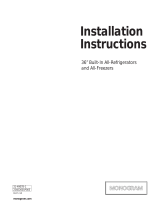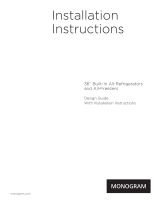
31-1000543 Rev. 0 10-20 GEA
TM
Si vous avez des questions, visitez notre site Web à: cafeappliances.com.
Au Canada, visitez: cafeappliances.ca
Réfrigérateurs encastrables à
congélateur en bas de 36" - CDB36
Instructions
d’installation
AVANT DE COMMENCER
Veuillez lire toutes ces instructions attentivement.
• IMPORTANT – Conservez ces instructions à l’usage de
l’inspecteur local. Observez tous les codes et décrets en vigueur.
•
Note à l’installateur – Assurez-vous de laisser ces
instructions au consommateur.
•
Note au consommateur - Conservez ces instructions
avec votre manuel d’utilisation pour
consultation ultérieure.
Si vous avez reçu un appareil endommagé, veuillez
communiquer immédiatement avec votre revendeur ou votre
entrepreneur.
Niveau de compétence – L’installation de cet appareil exige
des compétences de base en mécanique, menuiserie et plomberie.
La responsabilité d’une installation adéquate relève de l’installateur.
La garantie Cafe ne couvre pas les défectuosités du produit
causées par une installation inadéquate. Consultez le manuel
d’utilisation pour des renseignements sur la garantie.
AVERTISSEMENT
Risque de basculement.
Ces électroménagers sont lourds du haut, notamment lorsqu’une porte est ouverte, de sorte qu’ils doivent être fixés pour
prévenir un basculement vers l’avant susceptible d’occasionner des blessures graves ou la mort. Lisez et observez la totalité des
instructions d’installation pour connaître la façon de fixer l’électroménager sur le dispositif antibasculement.
AVERTISSEMENT
Risque d’incendie ou d’explosion.
Gardez les matériaux et les vapeurs inflammables à l’écart de l’appareil. L’omission de prendre cette précaution peut entraîner un
incendie, une explosion ou la mort.
AVERTISSEMENT
Pour réduire le risque d’étouffement pendant l’installation de ce produit, ne pas laisser les petites pièces
à la portée des enfants âgés de moins de 3 ans.
AVERTISSEMENT
Risque lié à la manipulation d’un objet lourd
Cet appareil est très lourd. Afin de réduire le risque de blessure pendant la manipulation et l’installation de cet électroménager, la
participation de 3 personnes est nécessaire à l’exécution d’une installation correcte.
AVERTISSEMENT
Gardez vos doigts éloignés des points de pincement. Les espaces entre les portes et ceux entre les
portes et l’armoire sont particulièrement restreints. Soyez prudent lorsque vous fermez les portes en présence d’enfants.
AVERTISSEMENT
Risque d’électrocution.
Branchez l’appareil dans une prise à 3 broches mise à la terre.
N’enlevez pas la broche de mise à la terre.
N’utilisez pas un adaptateur.
Cessez immédiatement l’utilisation d’un cordon électrique
endommagé. Si le cordon électrique est endommagé, son
remplacement doit être exécuté par un technicien en réparation
qualifié au moyen d’un cordon de rechange autorisé par le fabricant.
N’utilisez pas un cordon de rallonge avec cet électroménager.
Le non-respect de ces instructions peut occasionner un décès,
un incendie ou un choc électrique
Suivez les instructions de la section Mise à la terre de l’appareil.
Le circuit électrique auquel cet électroménager sera raccordé
doit comporter un disjoncteur ou un autre dispositif permettant de
couper l’alimentation électrique à l’appareil après l’installation.
LISEZ ET CONSERVEZ CES INSTRUCTIONS


























